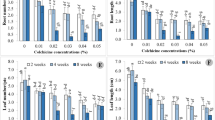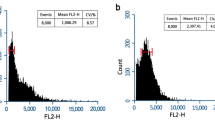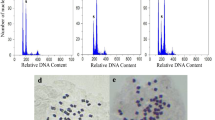Abstract
Plumbago auriculata Lam. (Plumbaginaceae) is an ornamental/medicinal flowering shrub. However, it could be stop growing under 5 °C resulting in its poor germplasm resources. Increasing the tolerance of polyploids to environmental stress will enrich its germplasm resources. In this study, we thus employed the stem segments and buds exposed to pendimethalin and trifluralin in vitro to conduct an effective polyploid protocol, in which buds were cultured for 7 days in MS medium with 800 μM. In this study, we have developed a novel polyploid identification method based on accuracy and efficiency. Early screening was performed based on the morphological characteristics of this plants, and then polyploidy was determined by flow cytometry. The number of chromosomes was determined by the chromosomal accounting. At the anatomical level, in comparison with diploids, the root parenchyma, stem collenchyma and tetraploid spongy tissues were thickened, the guard cell size and vascular bundles number were increased, and the stomata were widened; but the stomatal density was decreased. After 24 h of cold stress, the maximal quantum yield of photosystem II (Fv/Fm) and maximum primary yield of photochemistry of PSII (Fv/Fo) of diploids decreased significantly. Conversely, the minimal value of chlorophyll a fluorescence (Fo), relative electrical conductivity and malondialdehyde increased markedly. Accordingly, the cold tolerance of the tetraploids presented better than these of the diploids. Taken together, our study has first developed an effective protocol to obtain and identify the tetraploid of P. auriculate plants. Furthermore, it was proved that this polyploid has presented improving cold tolerance and enriching phenotypic properties. These findings could be useful for improving cold-tolerance breeding and enriching genetic diversity of P. auriculate plants.
Key message
We used stem segments and buds exposed to pendimethalin and trifluralin in vitro to conduct polyploids of Plumbago auriculata and compared characterizations including cold tolerance between diploids and polyploids.






Similar content being viewed by others
Abbreviations
- FCM:
-
Flow cytometry
- Fm:
-
Maximum fluorescence
- Fo:
-
Minimal value of chlorophyll a fluorescence
- Fv:
-
Variable fluorescence of photosystem II
- Fv/Fm:
-
The maximal quantum yield of photosystem II
- Fv/Fo:
-
Maximum primary yield of photochemistry of PSII
- MDA:
-
Malondialdehyde
- PSII:
-
Photosystem II
- REC:
-
Relative electrical conductivity
References
Baker NR (2004) Applications of chlorophyll fluorescence can improve crop production strategies: an examination of future possibilities. J Exp Bot 55:1607–1621
Banks JM (2017) Continuous excitation chlorophyll fluorescence parameters: a review for practitioners. Tree Physiol 37:1128–1136
Bao N, Ou J, Xu M, Guan F, Shi W, Sun J, Chen L (2017) Novel NO-releasing plumbagin derivatives: design, synthesis and evaluation of antiproliferative activity. Eur J Med Chem 137:88–95
Cai X, Cao Z, Xu S, Deng Z (2015) Induction, regeneration and characterization of tetraploids and variants in ‘Tapestry’ caladium. Plant Cell Tissue Organ Cult 120:689–700
Cao Q, Zhang X, Gao X, Wang L, Jia G (2018) Effects of ploidy level on the cellular, photochemical and photosynthetic characteristics in Lilium FO hybrids. Plant Physiol Biochem 133:50–56
Denaeghel HER, Van Laere K, Leus L, Lootens P, Van Huylenbroeck J, Van Labeke M (2018) The variable effect of polyploidization on the phenotype in escallonia. Front Plant Sci 9:12321–12334
Deng B, Du W, Liu C, Sun W, Tian S, Dong H (2012) Antioxidant response to drought, cold and nutrient stress in two ploidy levels of tobacco plants: low resource requirement confers polytolerance in polyploids? Plant Growth Regul 66:37–47
Dhingra D, Bansal S (2015) Antidepressant-like activity of plumbagin in unstressed and stressed mice. Pharmacol Rep 67:1024–1032
Dimitrov ADAB (2000) Influence of the herbicide stomp 330 on morphogenetic response of triticale callus cultures. Cytologica evidences for its mutagenic action. Cytologia 23:123–125
Dong N, Li Y, Qi J, Chen Y, Hao Y (2018) Nitric oxide synthase-dependent nitric oxide production enhances chilling tolerance of walnut shoots in vitro via involvement chlorophyll fluorescence and other physiological parameter levels. Sci Hortic 230:68–77
Du Y, Li J, Wang H, Tang X, Hu F (2012) Effects of high temperature stress on photosynthesis and Chlorophyll fluorescence of flag leaves of rice. J Ecol 31:2541–2548
Eng W, Ho W (2019) Polyploidization using colchicine in horticultural plants: a review. Sci Hortic 246:604–617
Gallone A, Hunter A, Douglas GC (2014) Polyploid induction in vitro using colchicine and oryzalin on Hebe ‘Oratia Beauty’: production and characterization of the vegetative traits. Sci Hortic 179:59–66
Gou Y, Zhang Y, Qi J, Kong L, Zhou Z, Liang S, Yang F, Liang H (2015) Binding and anticancer properties of plumbagin with human serum albumin. Chem Biol Drug Des 86:362–369
Gupta P, Sarkar A, Sandhu P, Daware A, Das MC, Akhter Y, Bhattacharjee S (2017) Potentiation of antibiotic against Pseudomonas aeruginosa biofilm: a study with plumbagin and gentamicin. J Appl Microbiol 123:246–261
Hollister JD (2014) Polyploidy: adaptation to the genomic environment. New Phytol 270:488
Hou W, Sun AH, Chen HL, Yang FS, Pan JL, Guan MY (2016) Effects of chilling and high temperatures on photosynthesis and chlorophyll fluorescence in leaves of watermelon seedlings. Biol Plant 60:148–154
Hussey G, Falavigna A (1980) Origin and production of in vitro adventitious shoots in the onion, Allium cepa L. J Exp Bot 125:1675–1686
Jaradat NA, Zaid AN, Hussein F (2016) Investigation of the antiobesity and antioxidant properties of wild Plumbago europaea and Plumbago auriculata from North Palestine. Chem Biol Technol Agric 3:156–158
Karimi R, Ershadi A (2015) Role of exogenous abscisic acid in adapting of ‘Sultana’ grapevine to low-temperature stress. Acta Physiol Plant 37:1–11
Kong S, Duan N, Liu B, Gao L, Liu B, Xu K (2016) Effects of different mutagens on the induction of tetraploid garlic. J Nucl Agric Sci 30:1067–1073
Lei T, Zhao C, Li, F, Gao S (2016) Optimization of Plumbago auriculata chromosome production and karyotype analysis. In: 2016 China ornamental horticulture symposium. Changsha, Hunan, p 5
Leitch IJ, Bennett MD (1997) Polyploidy in angiosperms. Trends Plant Sci 1:470–476
Li H (2003) Principles and techniques of plant physiological and biochemical experiments. Higher Education Press, Beijing, pp 37–281
Liu S, Chen S, Chen Y, Guan Z, Yin D, Chen F (2011) In vitro induced tetraploid of Dendranthema nankingense (Nakai) Tzvel. shows an improved level of abiotic stress tolerance. Sci Hortic 127:411–419
Liu H, Gao S, Jiang F, Lei X, Deng M, Wang C (2014) Comparative study on the occurrence of polyploidy in Dioscorea opposita Thunb. in vitro induced by pendimethalin and colchicine. J Nucl Agric Sci 28:1985–1992
Liu Y, Cai Y, He C, Chen M, Li H (2017) Anticancer properties and pharmaceutical applications of plumbagin: a review. Am J Chin Med 45:423–441
Luo Z, Iaffaldano BJ, Cornish K (2018) Colchicine-induced polyploidy has the potential to improve rubber yield in Taraxacum koksaghyz. Ind Crop Prod 112:75–81
Mao H, Chen M, Su Y, Wu N, Yuan M, Yuan S, Brestic M, Zivcak M, Zhang H, Chen Y (2018) Comparison on photosynthesis and antioxidant defense systems in wheat with different ploidy levels and octoploid triticale. IJMS 19:3006
Nadakuduti SS, Buell CR, Voytas DF, Starker CG, Douches DS (2018) Genome editing for crop improvement-applications in clonally propagated polyploids with a focus on potato (Solanum tuberosum L.). Front Plant Sci 132:1356–1476
Otto SP (2007) The evolutionary consequences of polyploidy. Cell 131:452–462
Oustric J, Morillon R, Luro F, Herbette S, Lourkisti R, Giannettini J, Berti L, Santini J (2017) Tetraploid Carrizo citrange rootstock (Citrus sinensis Osb. ×Poncirus trifoliata L. Raf.) enhances natural chilling stress tolerance of common clementine (Citrus clementina Hort. ex Tan). J Plant Physiol 214:108–115
Podwyszyńska M, Trzewik A, Marasek-Ciolakowska A (2018) In vitro polyploidisation of tulips (Tulipa gesneriana L.) Phenotype assessment of tetraploids. Sci Hortic 242:155–163
Porcel R, Bustamante A, Ros R, Serrano R, Mulet Salort JM (2018) BvCOLD1: a novel aquaporin from sugar beet (Beta vulgaris L.) involved in boron homeostasis and abiotic stress. Plant Cell Environ 41:2844–2857
Qiang S (2006) Botany. Higher Education Press, Beijing, p 134
Regalado JJ, Carmona Martín E, Castro P, Moreno R, Gil J, Encina CL (2015) Study of the somaclonal variation produced by different methods of polyploidization in Asparagus officinalis L. Plant Cell Tissue Organ Cult 122:31–44
Regalado JJ, Carmona-Martín E, Querol V, Veléz CG, Encina CL, Pitta-Alvarez SI (2017) Production of compact petunias through polyploidization. Plant Cell Tissue Organ Cult 129:61–71
Saghahazrati S, Ayatollahi SA, Kobarfard F, Zang BM (2020) The synergistic effect of glucagon-like peptide-1 and chamomile oil on differentiation of mesenchymal stem cells into insulin-producing cells. Cell J 21:371–378.
Schneider H, Liu H, Chang Y, Ohlsen D, Perrie LR, Shepherd L, Kessler M, Karger DN, Hennequin S, Marquardt J, Russell S, Ansell S, Lu NT, Kamau P, Lóriga J, Regalado L, Heinrichs J, Ebihara A, Smith AR, Gibby M (2017) Neo- and paleopolyploidy contribute to the species diversity of Asplenium -the most species-rich genus of ferns. J Syst Evol 55:353–364
Schurer R, Schippers JC, Kennedy MD, Cornelissen ER, Salinas-Rodriguez SG, Hijnen WAM, van der Wal A (2019) Enhancing biological stability of disinfectant-free drinking water by reducing high molecular weight organic compounds with ultrafiltration posttreatment. Water Res 164:114927. https://doi.org/10.1016/j.watres.2019.114927
Shi Q, Liu P, Wang J, Xu J, Ning Q, Liu M (2015) A novel in vivo shoot regeneration system via callus in woody fruit tree Chinese jujube (Ziziphus jujuba Mill.). Sci Hortic 188:30–35
Soltis PS, Soltis DE (2009) The role of hybridization in plant speciation. Annu Rev Plant Biol 60:561–588
Soltis DE, Albert VA, Leebens-Mack J, Bell CD, Paterson AH, Zheng C, Sankoff D, de Pamphilis CW, Wall PK, Soltis PS (2009) Polyploidy and angiosperm diversification. Am J Bot 96:336–348
Tavan M, Mirjalili MH, Karimzadeh G (2015) In vitro polyploidy induction: changes in morphological, anatomical and phytochemical characteristics of Thymus persicus (Lamiaceae). Plant Cell Tissue Organ Cult 122:573–583
Tian X, Zhou X, Gong N (2011) Application of flow cytometry in botanical research——detecting nuclear DNA content and ploidy level in plants. Chin Agric Sci Bull 9:21–27
Wang T, Pei Y, Guo X, Li J, Song X (2017) Identification of cold tolerance of three maize varieties at seedling stage. Chin J Nucl Agric 31:803–808
Yeap WC, Namasivayam P, Ooi TEK, Appleton DR, Kulaveerasingam H, Ho CL (2018) EgRBP42 from oil palm enhances adaptation to stress in Arabidopsis through regulation of nucleocytoplasmic transport of stress-responsive mRNAs. Plant Cell Environ 12:1456–1459
Zhang F, Xue H, Lu X, Zhang B, Wang F, Ma Y, Zhang Z (2015) Autotetraploidization enhances drought stress tolerance in two apple cultivars. Trees 29:1773–1780
Zhou B, Guo Z (2009) Calcium is involved in the abscisic acid-induced ascorbate peroxidase, superoxide dismutase and chilling resistance in Stylosanthes guianensis. Biol Plantarum 53:63–68
Zhou H, Zeng W, Yan H (2017) In vitro induction of tetraploids in cassava variety ‘Xinxuan 048’ using colchicine. Plant Cell Tissue Organ Cult 128:723–729
Zhou R, Wu Z, Wang X, Rosenqvist E, Wang Y, Zhao T, Ottosen C (2018) Evaluation of temperature stress tolerance in cultivated and wild tomatoes using photosynthesis and chlorophyll fluorescence. Hortic Environ Biotechnol 59:499–509
Acknowledgements
This work was partial supported by the Breeding Project of the Sichuan Province 13th Five-Year Plan to Tackle Key Problems, China (No. 2016NYZ0038).
Author information
Authors and Affiliations
Contributions
YJ wrote the manuscript. YJ, GH and WL performed the experiments. SG and TL assisted with the experimental design. SL, SG, JH, and YL helped to improve the manuscript. XC, QL, LY, DH and JL assisted with analyzing the experimental results. SL, YJ and SG revised the original manuscript based on the comments of reviewers and editors.
Corresponding author
Ethics declarations
Conflict of interest
The authors declare that they have no conflict of interest.
Additional information
Communicated by Alison M.R. Ferrie.
Publisher's Note
Springer Nature remains neutral with regard to jurisdictional claims in published maps and institutional affiliations.
Rights and permissions
About this article
Cite this article
Jiang, Y., Liu, S., Hu, J. et al. Polyploidization of Plumbago auriculata Lam. in vitro and its characterization including cold tolerance. Plant Cell Tiss Organ Cult 140, 315–325 (2020). https://doi.org/10.1007/s11240-019-01729-w
Received:
Accepted:
Published:
Issue Date:
DOI: https://doi.org/10.1007/s11240-019-01729-w




